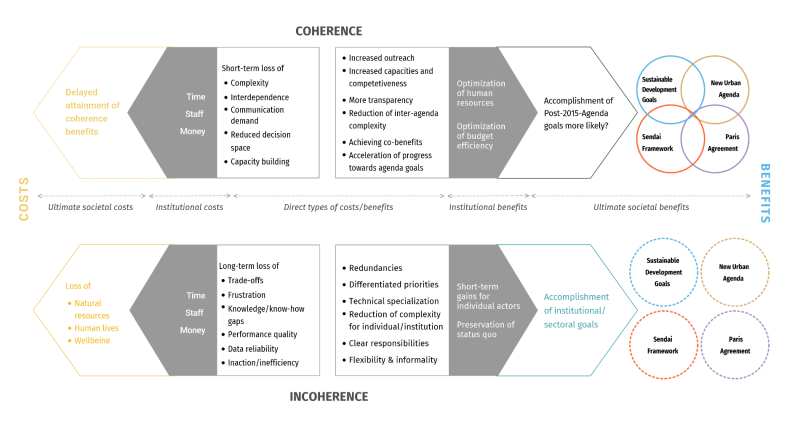Costs of (In)Coherence

Introduction
The need to strengthen disaster and climate resilience is anchored in four post-2015 agendas: Sendai Framework, Agenda 2030, Paris Agreement and New Urban Agenda. As states are facing the concurrent implementation of these global agreements, calls to increase cooperation, to strengthen coherence and to break down siloed organizational structures are emerging. However, more coherent implementation processes remain a challenge for policy and practice. In addition, questions of the practical feasibility arise, such as the costs of (in)coherence.
Supported by GIZ within the framework of GIDRM, which is funded by the BMZ, researchers at the United Nations University – Institute for Environment and Human Security (UNU-EHS) looked into the costs and benefits of coherence and incoherence to develop a better understanding of how and to which extent potential synergies between the post-2015 global agendas should be used. The study draws on a comprehensive literature review followed by an in-depth empirical analysis of two case studies: Mexico and the Philippines.
Key conclusions
- Policy formulation and implementation for disaster risk reduction, climate change adaptation and overall development is still often happening in an incoherent and siloed manner despite the fact that coherent approaches have been postulated for years.
- This incoherence implies different types of costs, many of which are not currently on the agenda of policymakers.
- But in many respects incoherence does not emerge randomly or accidentally; rather, distinct drivers of incoherence are at play which need to be understood in order to enable coherence-building.
- In some respects, incoherence even brings benefits to policy processes and outcomes, particularly in the short term. Finding substitutes for these benefits is an essential ingredient to coherence-building.
- Despite initial benefits of incoherence in many policy processes, the long-term costs of incoherence are far higher, making the case for coherence-building but also highlighting the difficulties of taking the first steps in this direction. (Sandholz and others, 2020).
Please find the full study “Costs and benefits of (in)coherence: Disaster Risk Reduction in the Post-2015-Agendas” here. The following figure provides a typology of the costs and benefits of (in)coherence derived from the country studies:
Disclaimer
Sandholz, Simone, and others (2020). Costs and benefits of (in)coherence: Disaster Risk Reduction in the Post-2015-Agendas. Synthesis Report. Bonn: United Nations University – Institute for Environment and Human Security (UNU-EHS).
This report presents the synthesized results of a study supported by the Deutsche Gesellschaft für Internationale Zusammenarbeit (GIZ) within the framework of the Global Initiative on Disaster Risk Management (GIDRM), which is funded by the German Federal Ministry of Economic Cooperation and Development (BMZ). Research for this study was conducted between September 2018 and August 2019.
More information
-
Common Ground Between the Paris Agreement and the Sendai Framework
Learn more about the potential synergies between climate change adaptation and disaster risk reduction approaches.
